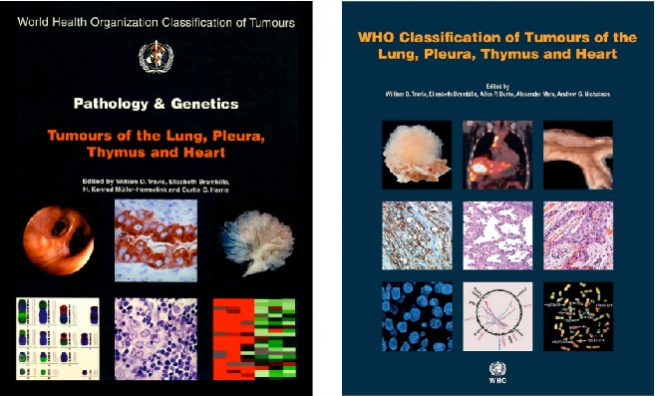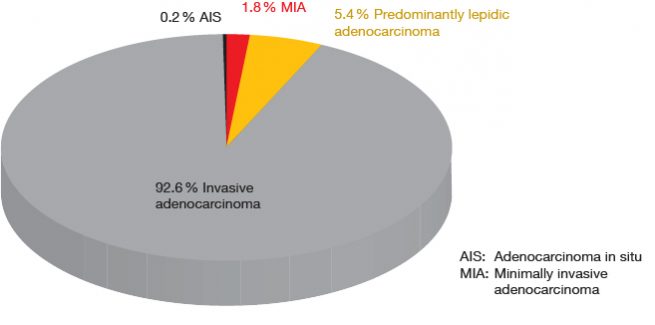Pathology and WHO classification of tumours of the lung: what is new?
The WHO classification of tumours of the lung, pleura, thymus and heart that was published in 2004 [1] was revised in 2015 [2] (Figure 1). Leonhard Müllauer, MD, Institute of Pathology, Medical University of Vienna, Austria, summarised the changes.
Figure 1: WHO classifications of tumours of the lung, pleura, thymus and heart published in 2004 (left) and 2015 (right)
Adenocarcinoma in situ
“The 2004 classification had only one type of pre-invasive lesion, called atypical adenomatous hyperplasia”, Dr. Müllauer explained. “This type is still part of the new classification, but a new entity has been added, which is adenocarcinoma in situ.” By definition, atypical adenomatous hyperplasia is a localised, small (≤ 0.5 cm) proliferation of mildly to moderately atypical type II pneumocytes and/or Clara cells that line the alveolar walls. Adenocarcinoma in situ, on the other hand, is localised and small (≤ 3 cm), with growth restricted to neoplastic cells along pre-existing alveolar structures. “This growth pattern is called pure lepidic growth,” Dr. Müllauer said. The term “lepidic growth” replaces the older expression of bronchioloalveolar carcinoma (BAC). Adenocarcinoma in situ shows no stromal, vascular or pleural invasion, and no pattern of invasive growth. Most of these tumours are non-mucinous, although some are mucinous and some are mixed. After complete resection, good disease-specific long-term survival can be expected.
(Minimally) invasive adenocarcinoma
While the 2004 classification related to the term of adenocarcinoma only, the 2015 classification differentiates between minimally invasive adenocarcinoma and invasive adenocarcinoma. Minimally invasive adenocarcinoma is small (≤ 3 cm) and solitary, with a predominantly lepidic growth pattern and ≤ 5 mm invasion. This type of tumour is usually non-mucinous. Invasion is defined by infiltration of the stroma or the presence of a non-lepidic growth pattern. Minimally invasive adenocarcinoma does not invade vessels or pleura; furthermore, neither tumour necrosis nor spread through air spaces are involved. Again, disease-specific survival after resection approaches 100 %.
The definition of invasive adenocarcinoma according to the 2015 classification differs from adenocarcinoma as defined in 2004, with regard to the subtypes. The entity of non-mucinous BAC has been replaced by the lepidic (non-mucinous) type. The other categories now included are the acinar, papillary, micropapillary and solid variants. “The micropapillary type was introduced as a new entity after it had been recognised as a specific pattern,” Dr. Müllauer noted. “These tumours appear to convey unfavourable prognosis.”
Further variants of invasive adenocarcinoma include the mucinous, colloid, foetal and enteric types. Almost all of these categories differ from those classified in the 2004 version. The former terms of mucinous adenocarcinoma and mucinous cystadenocarcinoma are now summarised as colloid adenocarcinoma. Enteric adenocarcinoma represents a novel subtype, which histologically resembles colorectal carcinoma. “In these cases, it is important to rule out primary tumours of the colon that have spread to the lung,” Dr. Müllauer pointed out. “The pathologist should indicate this in his report.” Moreover, the term of signet-ring/clear-cell adenocarcinoma has been removed. Adenocarcinoma in situ, minimally invasive adenocarcinoma, and predominantly lepidic adenocarcinoma are infrequent compared to invasive adenocarcinoma, according to an analysis of 514 patients with stage I tumours (Figure 2).
Figure 2: Frequency of adenocarcinoma in situ, minimally invasive adenocarcinoma, and predominantly lepidic adenocarcinoma, in 514 patients with stage I adenocarcinoma of the lung
Other histologies
For squamous-cell carcinoma, the new classification recognises pre-invasive lesions (squamous cell carcinoma in situ) on the one hand, and invasive squamous cell carcinoma on the other. The newly defined morphological subtypes of the invasive variant are keratinising, non-keratinising, and basaloid. Large-cell carcinoma, according to WHO 2015, is an undifferentiated, non–small-cell carcinoma that lacks the features of small-cell carcinoma, adenocarcinoma and squamous-cell carcinoma. “This type of tumour is diagnosed only in resection specimens, because lung cancer is very heterogeneous and large-cell structures in a biopsy might only represent a small component of the tumour,” Dr. Müllauer stressed.
The Table lists the other malignant epithelial lung tumours that are mentioned in the new classification. Here, EBV-associated lymphoepithelioma-like carcinoma and nuclear-protein-in-testis (NUT) carcinoma are new entities. NUT tumours are very rare, but they might also be under-diagnosed. As specific immunohistochemistry is required for detection of the NUT protein, increased use of this type of analysis might increase the numbers of diagnosed cases. “NUT carcinoma is a very aggressive tumour with a poor prognosis”, Dr. Müllauer explained. For neuroendocrine tumours, the classification differentiates between small-cell carcinoma, large-cell neuroendocrine carcinoma, and carcinoid tumours. Carcinoid tumours, which comprise both typical and atypical variants, are less aggressive than the other types.
NOS is largely obsolete
The new stratification highlights the importance of accurate subtyping. Immunohistochemistry is mandatory in this context. Most laboratories use panels of antibodies against the following proteins: TTF-1, cytokeratin 7 and napsin for the diagnosis of adenocarcinoma; p40, p63 and cytokeratin 5/6 for squamous-cell carcinoma; and chromogranin A and synaptophysin for neuroendocrine tumours. Cytokeratin 20, CDX2 and other markers contribute to differentiation between primary tumours and metastatic lesions. Semi-quantitative subtyping of invasive adenocarcinoma is recommended. “All of the components of the tumour, such as acinar, papillary or solid, should be specified in the report, and the predominant morphological pattern should be defined,” Dr. Müllauer emphasised. As immunohistochemistry basically allows for subtyping of all carcinomas, the term of NSCLC not otherwise specified (NOS) should be used as little as possible.
Also, the 2015 classification contains a specific terminology that relates the findings in small biopsies and cytological specimens to those in resection specimens, which are more likely to be correct. “For instance, the classification states that cells with the appearance of adenocarcinoma and a lepidic pattern according to a small biopsy or cytology might represent adenocarcinoma in situ, minimally invasive adenocarcinoma, or invasive adenocarcinoma with a lepidic component, according to the resection specimen,” Dr. Müllauer said. Non-small-cell lung cancer (NSCLC) NOS tends to be large-cell carcinoma, and NSCLC with neuroendocrine morphology and positive neuroendocrine markers is large-cell neuroendocrine carcinoma of the lung in most cases. Only when there are unequivocal findings (i. e., distinct morphology, matching immunohistochemical staining) are the terminologies for small biopsies and cytology the same as for resection specimens.
REFERENCES
- Travis WD et al., Pathology and Genetics of Tumours of the Lung, Pleura, Thymus and Heart, IARCPress, Lyon 2004, ISBN 92 832 2418 3
- Travis WD et al., WHO Classification of Tumours of the Lung, Pleura, Thymus and Heart, Fourth edition, ISBN-13 9789283224365







